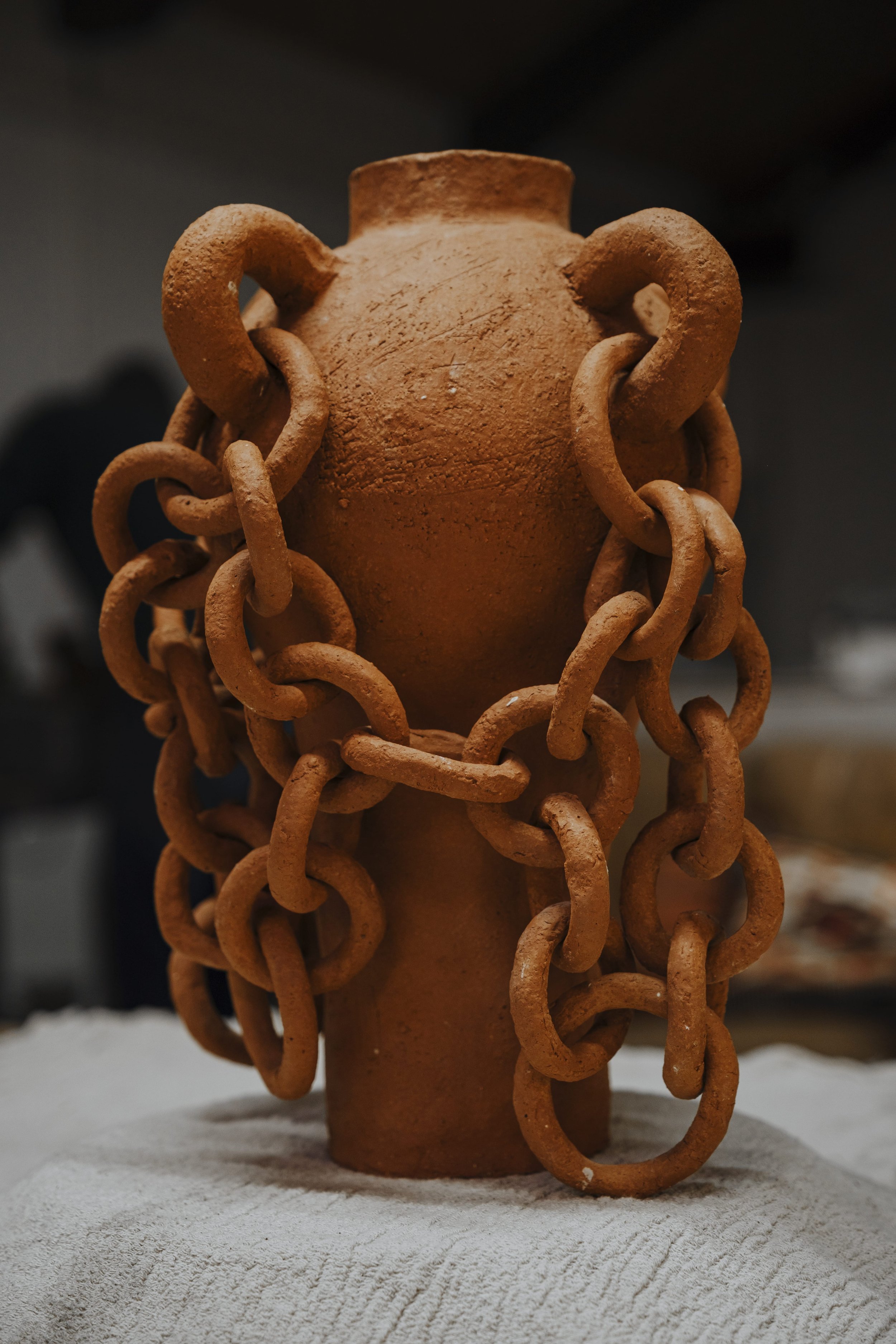Prometheus
For although Zeus may batter my body, he cannot shatter my spirit
The vessel is made from raw, unglazed terracotta, mirroring the clay from which Prometheus is said to have created humanity. This choice of material emphasizes the connection between earth and humankind, as well as the raw, unrefined nature of Prometheus's defiance and creativity.
Form and Symbolism:
Tall, Elongated Body: The vessel is tall, with an elongated, almost human-like form that evokes the stretched and suffering figure of Prometheus, bound to a rock. The shape may suggest a body, symbolizing both the creation of man from clay and Prometheus's own torment.
Chains: Terracotta chains zig zag around the vessel, climbing upwards. The chains are not static; they are designed to move, creating a tactile interaction that mirrors Prometheus’s eternal struggle against his bindings. The chains symbolize the weight of punishment and the consequences of rebellion, but their potential to move suggests the spirit's indomitable nature and the possibility of freedom.
Raw, Earthy Texture: The unglazed, raw terracotta gives the vessel a rugged texture, evoking the harshness of Prometheus’s punishment and the raw power of creative genius. This texture symbolizes the primal and unyielding spirit that refuses to be broken, much like Prometheus himself.
Cultural Context and Mythology:
Prometheus is a powerful figure in Greek mythology, a Titan who defied Zeus by stealing fire and giving it to humanity, thereby granting them knowledge, warmth, and the spark of civilization. His actions led to severe punishment: bound to a rock, with an eagle eating his liver daily, which would regenerate every night. Despite this endless torture, Prometheus remains a symbol of resistance, creativity, and the unyielding spirit of humanity.
The phrase "For although Zeus may batter my body, he cannot shatter my spirit" encapsulates Prometheus's resilience and determination. It highlights the idea that while physical punishment can be inflicted, the spirit and willpower remain unbroken.
Interpretation and Use:
The Prometheus Vessel serves as a powerful reminder of the strength of the human spirit and the torments faced by those who dare to challenge the status quo. It symbolizes the creative genius and the pain often associated with it. The movable chains encourage interaction, reminding the user of the struggle against constraints and the continuous striving for improvement and freedom.
This vessel could be placed in a contemplative space, an art exhibit, or a personal sanctuary as a symbol of endurance, creativity, and the eternal quest for knowledge and freedom. It can serve as a muse for those who face their own trials, reminding them of the resilience of the human spirit against all odds.
For although Zeus may batter my body, he cannot shatter my spirit
The vessel is made from raw, unglazed terracotta, mirroring the clay from which Prometheus is said to have created humanity. This choice of material emphasizes the connection between earth and humankind, as well as the raw, unrefined nature of Prometheus's defiance and creativity.
Form and Symbolism:
Tall, Elongated Body: The vessel is tall, with an elongated, almost human-like form that evokes the stretched and suffering figure of Prometheus, bound to a rock. The shape may suggest a body, symbolizing both the creation of man from clay and Prometheus's own torment.
Chains: Terracotta chains zig zag around the vessel, climbing upwards. The chains are not static; they are designed to move, creating a tactile interaction that mirrors Prometheus’s eternal struggle against his bindings. The chains symbolize the weight of punishment and the consequences of rebellion, but their potential to move suggests the spirit's indomitable nature and the possibility of freedom.
Raw, Earthy Texture: The unglazed, raw terracotta gives the vessel a rugged texture, evoking the harshness of Prometheus’s punishment and the raw power of creative genius. This texture symbolizes the primal and unyielding spirit that refuses to be broken, much like Prometheus himself.
Cultural Context and Mythology:
Prometheus is a powerful figure in Greek mythology, a Titan who defied Zeus by stealing fire and giving it to humanity, thereby granting them knowledge, warmth, and the spark of civilization. His actions led to severe punishment: bound to a rock, with an eagle eating his liver daily, which would regenerate every night. Despite this endless torture, Prometheus remains a symbol of resistance, creativity, and the unyielding spirit of humanity.
The phrase "For although Zeus may batter my body, he cannot shatter my spirit" encapsulates Prometheus's resilience and determination. It highlights the idea that while physical punishment can be inflicted, the spirit and willpower remain unbroken.
Interpretation and Use:
The Prometheus Vessel serves as a powerful reminder of the strength of the human spirit and the torments faced by those who dare to challenge the status quo. It symbolizes the creative genius and the pain often associated with it. The movable chains encourage interaction, reminding the user of the struggle against constraints and the continuous striving for improvement and freedom.
This vessel could be placed in a contemplative space, an art exhibit, or a personal sanctuary as a symbol of endurance, creativity, and the eternal quest for knowledge and freedom. It can serve as a muse for those who face their own trials, reminding them of the resilience of the human spirit against all odds.

